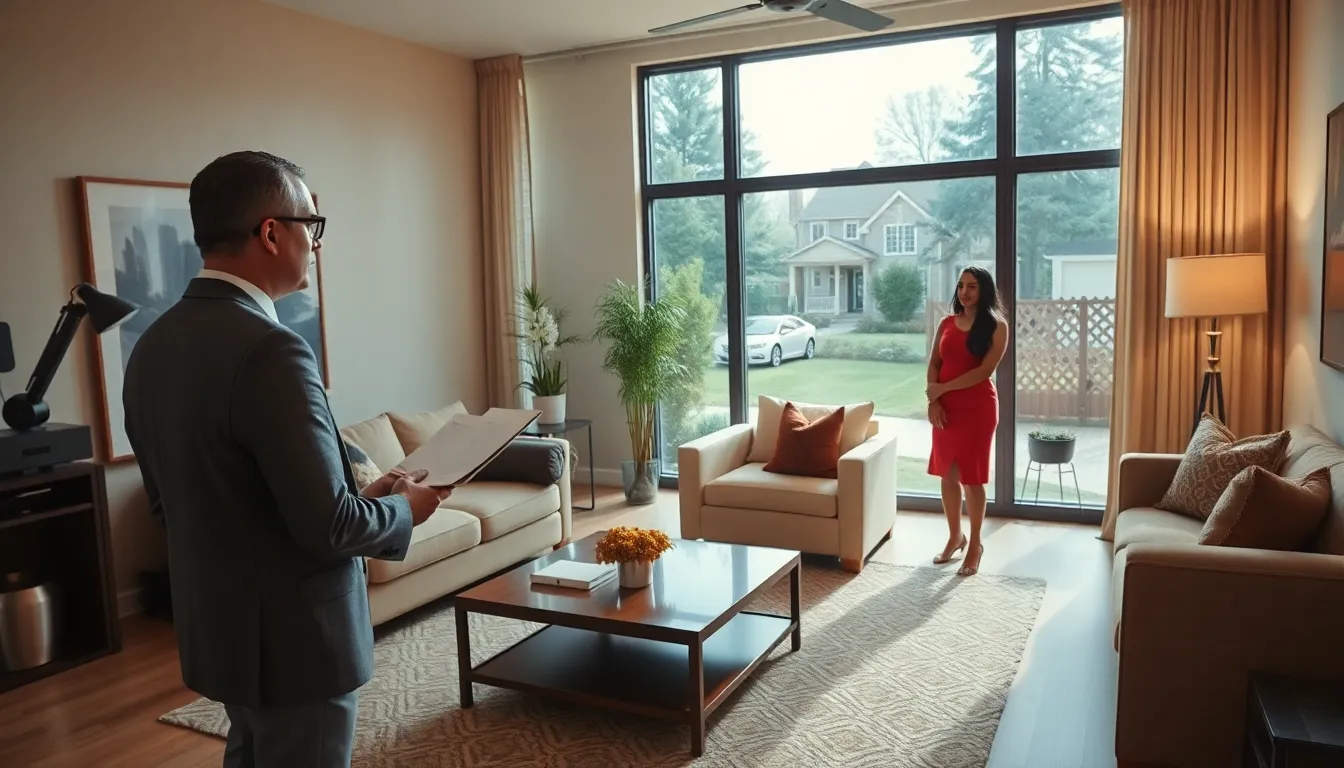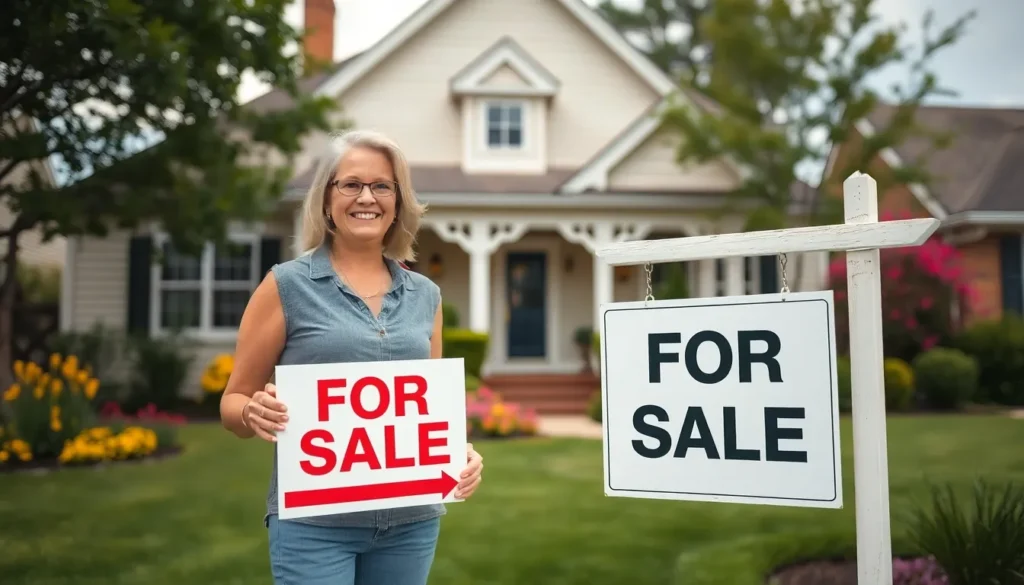Table of Contents
ToggleSelling a home can feel like a rollercoaster ride—thrilling yet terrifying. One moment, you’re dreaming of big offers and the next, you’re knee-deep in paperwork, wondering if you should just sell your home to the neighbor’s cat. Fear not! With the right guidance, this process can be smoother than a freshly waxed floor.
Understanding the Home Selling Process
Selling a home involves multiple steps that can feel daunting. Clear understanding of the process makes it less overwhelming and more manageable.
Preparing for Sale
Preparation begins with making the home appealing to potential buyers. Cleaning, decluttering, and staging are essential tasks. Each room should showcase its purpose while creating a warm atmosphere. Upgrading fixtures can enhance overall appeal. Investing in minor repairs also increases value. Taking high-quality photos ensures listings stand out online. Since first impressions are crucial, the exterior should look inviting. Curated landscaping attracts buyers and highlights the property’s best features.
Setting a Realistic Price
Setting a competitive price is key to attracting buyers quickly. Researching comparable sales in the neighborhood provides valuable insights. Adjusting for unique aspects of the property can help find the right number. Working with a real estate agent often offers market expertise that aids in this decision. Analyzing recent sales data and current market conditions avoids overpricing or underpricing. Effective pricing strategies lead to stronger offers and quicker sales. Emotional attachment may cloud judgment, so relying on data ensures a sound decision.
Marketing Your Home

Effective marketing strategies play a vital role in selling a home quickly and at the best price. A mix of traditional and digital approaches maximizes visibility and attracts potential buyers.
Traditional Marketing Strategies
Print advertisements in local newspapers or real estate magazines can reach interested buyers in the community. Hosting open houses invites prospective buyers to explore the property firsthand, creating a welcoming environment. For sale signs placed prominently on the lawn enhance visibility in the neighborhood. Flyers with high-quality images and crucial details can be distributed in the area or at local businesses. Networking with local real estate agents can generate referrals, tapping into their existing client base.
Digital Marketing Tactics
Social media platforms like Facebook and Instagram offer extensive reach when promoting a home. Utilizing high-quality photos and engaging videos attracts potential buyers online. Listing properties on real estate websites increases exposure and helps connect with a wider audience. Email marketing campaigns targeting interested buyers provide detailed information about the property and invite inquiries. Virtual tours create immersive experiences, allowing remote buyers to explore the home before visiting in person.
Showcasing Your Home
Showcasing a home effectively attracts potential buyers. Attention to detail in presentation makes a significant difference.
Staging Your Home
Staging a home enhances its appeal. Use furniture and decor to create a welcoming atmosphere that allows buyers to envision their lives there. Rooms should feel spacious, so remove excess items and consider neutral color palettes. Highlight key features like fireplaces or large windows to draw eyes. Incorporate natural light by opening curtains and turning on lights to make spaces feel inviting. Professionally taken photographs should reflect these efforts, showcasing the home’s best angles to online viewers.
Conducting Open Houses
Conducting open houses offers buyers the opportunity to experience the home firsthand. Schedule events during weekends or early evenings for maximum attendance. Prepare the space by ensuring cleanliness and a pleasant scent, like freshly baked cookies or brewed coffee. Provide informative brochures that include details about the home, neighborhood, and nearby amenities. Engage visitors during their tour, answering questions and highlighting unique features. Follow up with attendees after the event to gauge interest and build relationships.
Navigating Offers and Negotiations
Navigating offers and negotiations involves careful consideration and strategic decision-making. Once offers arrive, evaluation becomes essential to recognize their strengths and weaknesses.
Evaluating Offers
Evaluating offers includes analyzing not just the proposed price but also contingencies and buyer qualifications. Assess the financial stability of potential buyers by looking at their pre-approval letters and cash offers. Other terms, such as flexibility regarding closing dates or request for repairs, can impact the attractiveness of an offer. Compare multiple offers to determine how they align with personal priorities and timelines. Strong offers may involve fewer contingencies or all-cash proposals and can lead to quicker transactions.
Counteroffers and Acceptance
Counteroffers play a critical role in negotiations. When an offer doesn’t meet expectations, crafting a counteroffer allows sellers to communicate their needs. Use an assertive yet approachable tone to outline desired terms, such as price adjustments or requested repairs. Additionally, sellers can propose timelines that meet their personal schedules. Accepting an offer should only happen once all parties agree on the essential terms. Clear communication helps ensure mutual understanding and satisfaction throughout this process. All these strategies aid in maximizing outcomes during negotiations.
Closing the Sale
Closing entails finalizing the sale of a home, requiring careful attention to necessary documentation and understanding closing costs.
Necessary Documentation
Documentation is essential for closing a home sale. Buyers and sellers need to prepare various documents, including the purchase agreement, title report, and disclosures. A closing statement outlines all financial details and transactions, providing clarity for both parties. The seller’s property disclosure statement informs buyers about any known issues. Additionally, mortgage payoff statements may be needed to settle existing loans. Organizing these documents ensures a smooth closing process, reducing potential setbacks.
Understanding Closing Costs
Closing costs represent various expenses associated with finalizing a real estate transaction. On average, these costs range from 2% to 5% of the home price. Sellers typically pay agent commissions, title insurance, and transfer taxes. Buyers, on the other hand, may encounter inspection fees, appraisal fees, and loan origination fees. Understanding who pays what can streamline negotiations. Preparing for these costs ahead of time helps avoid surprises on closing day, ensuring a successful transaction.
Selling a home can be a complex journey filled with emotional highs and lows. However with the right preparation and strategies in place it can also be a rewarding experience. By focusing on the essential steps from staging and pricing to effective marketing and negotiation sellers can navigate this process with confidence.
Understanding the intricacies of paperwork and closing costs is crucial for a smooth transaction. With careful planning and the right support sellers can achieve their goals and move forward to the next chapter of their lives. Embracing the journey will lead to a successful home-selling experience.







